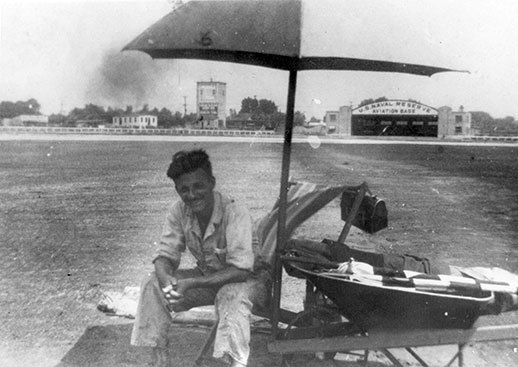
Archie League and the Genesis of Federal Air Traffic Control
Archie League — a name reverently whispered through the annals of aviation history and the namesake of NATCA’s annual award presented at our Union’s Communicating for Safety conference each year, honoring the best aviation “saves” by air traffic controllers — stands as a symbol of dedication, innovation, and unwavering commitment to safety within the realm of air traffic control (ATC). League’s story intertwines with the birth of the Federal Aviation Administration (FAA) and the evolution of modern air traffic management, forever altering the landscape of aviation.
League, born in 1907, began his journey in ATC in the early days of aviation, an era characterized by rudimentary communication and the absence of standardized procedures. Working as an ATC specialist for the St. Louis District of the Bureau of Air Commerce, League’s legacy was cemented in 1929 when he showcased his remarkable ingenuity and instinctive ability to navigate crises during a severe weather incident.
In October 1929, a small biplane faced severe weather conditions, including dense fog, as it approached an airfield in St. Louis, Mo. (now known as Lambert-St. Louis International Airport). As the aircraft neared the field, League transmitted a series of calm and concise instructions to guide the pilot to a safe landing. This pivotal moment marked the first recorded instance of an ATC specialist guiding an aircraft to safety using only voice communication, laying the foundation for the role of air traffic controllers as unsung heroes of the skies.
League’s legacy transcends the realm of ATC. His actions demonstrated the pivotal role of communication, quick thinking, and human interaction in the complex world of aviation, reaffirming the principle that a single voice can guide an aircraft and its passengers through the darkest of storms.
The genesis of federal air traffic control is a tale of the tireless pursuit of safer skies. In the early years of aviation, a lack of standardization and oversight led to a haphazard approach to managing air traffic. As the skies became increasingly congested, accidents and near-miss incidents highlighted the need for a more organized and regulated system.
The foundation for federal ATC was laid with the passage of the Air Commerce Act of 1926. This act empowered the Secretary of Commerce to establish air traffic rules, develop air navigation facilities, and provide for the safe and efficient use of airspace. It was under this framework that Archie League and other pioneers began to shape the future of air traffic management.
The St. Louis incident of 1929 served as a catalyst for change. The realization that trained professionals could guide aircraft to safety through effective communication and coordination led to the establishment of more air traffic control facilities across the nation. As aviation technology advanced, the need for a centralized authority to oversee air traffic management became evident.
In 1938, the Civil Aeronautics Act created the Civil Aeronautics Authority (CAA) to regulate and oversee civil aviation in the U.S. The CAA’s responsibilities included air traffic control, safety regulations, and the development of air navigation systems. The vision of safer skies began to take shape as the CAA implemented a network of air traffic control facilities, each staffed with skilled controllers like Archie League.
The culmination of these efforts arrived in 1958 with the creation of the Federal Aviation Agency (FAA), later renamed the Federal Aviation Administration. The FAA was established as an independent agency within the Department of Transportation, tasked with promoting the safety and efficiency of civil aviation. The advent of radar, radio communication, and sophisticated navigation systems revolutionized air traffic control, enabling controllers to manage airspace with unprecedented precision.
Archie League’s pioneering spirit and the collective dedication of air traffic controllers played a vital role in the creation and evolution of federal air traffic control. Today, the FAA oversees a vast network of air traffic control facilities, ensuring the safety and efficiency of millions of flights each year.
The story of Archie League and the genesis of federal air traffic control serves as a testament to the power of human ingenuity and collaboration in shaping the course of aviation history. From the brave actions of a single air traffic controller guiding a struggling aircraft to safety, to the establishment of a comprehensive regulatory framework, this narrative encapsulates the relentless pursuit of safer skies and the enduring legacy of those who dedicate their lives to the noble cause of aviation safety.

